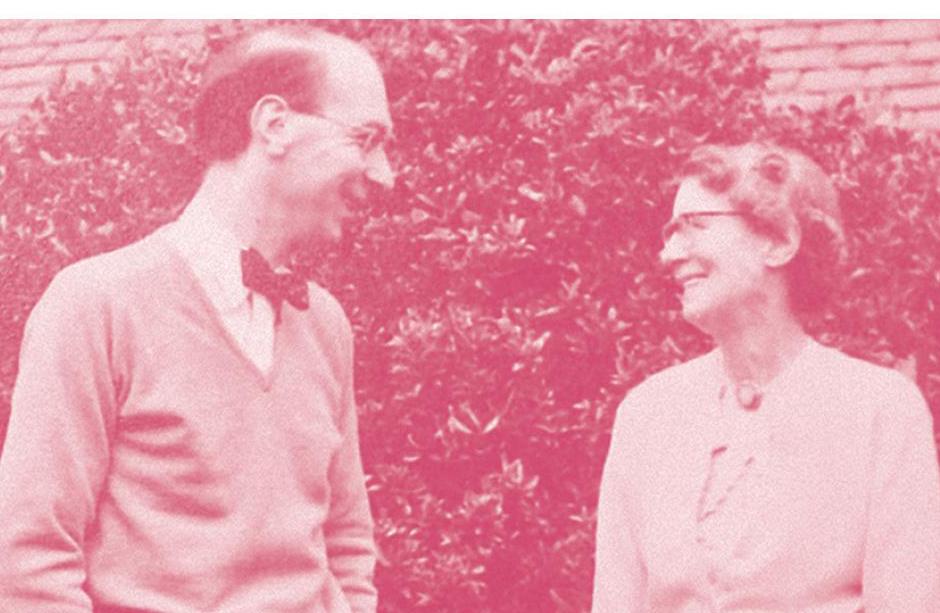Newly Seen Letters Show Philip Larkin’s Close Relationship with Mother书信揭示拉金与母亲的亲密关系
2021-07-25黄美凤
黄美凤

Philip and Eva Larkin corresponded twice weekly for about 35 years, with the pair exchanging minute details of one anothers daily lives. 在大約35年的时间里,菲利普和伊娃·拉金每周通信两次,母子二人在信中交流彼此日常生活中琐碎的细节。
He was terrified of marriage, living a life of tangled relationships with women who became his muses. Poet Philip Larkins view of marriage may partly have been coloured1 by his mothers warnings of its disadvantages, previously unpublished letters reveal.
In 1952, Eva Larkin told her son: “Marriage would be no certain guarantee as to socks being always mended, or meals ready when they are wanted. Neither would it be wise to marry just for those comforts. There are other things just as important.”
The following year, she quoted from a George Bernard Shaw novel in offering further relationship advice: “I have just finished reading Love Among the Artists … in which occurs this passage ‘No: it is marriage that kills the heart and keeps it dead. Better starve the heart than overfeed it. Better still to feed it only on fine food, like music. In a way, I agree with him... Better to have lived a full life, I think.”
The correspondence was featured in a book, titled Writers and Their Mothers, exploring the maternal influence on literary offspring from Shakespeare onwards. A chapter on Larkin, one of the greatest poets of the 20th century, is written by Philip Pullen, who has drawn on thousands of largely unpublished letters held by the University of Hull, where Larkin worked as librarian from 1955.
Larkin biographer James Booth published a selection of the correspondence in a major book, titled Letters Home, for Faber & Faber in November. He described the previously unpublished material as “very significant”, noting that passages chosen by Pullen show that “the relationship was deeper and more valuable to Larkin than anybody might have thought”: “Its rather surprising to hear Eva trying to put her son off marriage.”
Mother and son wrote to each other twice weekly for about 35 years from 1940, when Larkin went to Oxford University. Pullen notes that no other collection of a writers dialogue with his mother contains such intimate and minute detail of each others day-to-day life.
Pullen writes that, in biographical terms, it is Larkins father, Sydney, who has taken centre stage, notably “his ardour for National Socialism during the 1930s and the impact that his adventurous admiration for English literature had on his son”: “Eva has been portrayed as a shadowy, background figure—subservient2 to her husband, nervous, continually whining, and contributing significantly to their unhappy pairing.”
Larkins long-standing relationships included Monica Jones, an English lecturer, but he shied from tying the knot3 and strayed4. “To me it was dilution”, he wrote of marriage in his poem Dockery and Son.
Booth said: “He couldnt marry anyone because he was so involved with his mother. Writing to her twice a week, he also visited her every fortnight or so. He would come down from Hull to Loughborough, and then he would visit Monica in Leicester. But he was living in Hull, which is where he got involved with Maeve Brennan in the library… Youve got this really tangled emotional situation. The mother is the key element. People have always half recognised that, but never been able to see it properly.”
He added: “Philip scarcely needed Evas advice against entering into marriage for the sake of domestic comfort… So much was he his mothers son that he always darned his own socks and cooked for himself. Each coped with their depressive pessimism in their own way: Eva underwent psychiatric treatment…; he wrote poems. Most important of all, their postal conversation kept alive the poets sense of the loveliness of ‘everyday things, so essential to such poems as ‘Love Songs in Age and ‘Faith Healing.”
Writers and Their Mothers was published on 1 March 2018, before Mothers Day5. Its editor, Prof Dale Salwak, whose books include Philip Larkin: The Man and His Work, said: “We now have a profounder understanding of just what an influence Eva was on Larkin as a man and therefore on his poetry.” ■
詩人菲利普·拉金恐惧婚姻。他的一生中,与带给他创作灵感的女性总是陷入恋情且关系错综复杂。此前从未发表过的一些信件透露,拉金的婚姻观可能部分受到了他母亲的影响:母亲总是告诫他婚姻的种种弊端。
1952年,伊娃·拉金告诉儿子:“结了婚也不一定能过上袜子破了总有人给补、饿了就能吃上饭的舒适生活,而且只为享受舒适生活而结婚也是不明智的。生活中还有其他同样重要的事情。”
次年,她引用了萧伯纳一部小说中的内容进一步提出婚恋建议:“我刚刚读完《艺术家之间的爱情》……书中出现了这样一段:‘不:是婚姻杀死了人的心,让它如一潭死水。与其把心喂得太饱,还不如让它挨饿。不如干脆只给它喂像音乐这样精美的食物。在某种程度上,我同意他的看法……我觉得,过一种充实的人生应该会更好。”
《作家和他们的母亲》一书收录了这些信件。这本书探讨了自莎士比亚以来,后世作家的母亲对他们创作的影响。书中有一章是关于拉金的,他是20世纪最伟大的诗人之一。该章节由菲利普·普伦撰写,他参考了数千封基本未曾公开发表过的书信,这些信件为赫尔大学所有。拉金本人从1955年起就一直在赫尔大学担任图书管理员。
2018年11月,拉金的传记作家詹姆斯·布思将为费伯与费伯出版社出版了一本名为《家书》的重要著作,其中精选了拉金的书信。他称这些之前从未发表过的信件“意义非凡”,并指出其中普伦所摘选的段落表明“对于拉金来说,他与母亲的关系可能比任何人想象的都更深厚,也更珍贵”:“听到伊娃试图阻止儿子步入婚姻殿堂还是颇令人感到意外的。”
从1940年拉金进入牛津大学开始,他与母亲每周通信两次,就这样持续了大约35年。普伦指出,其他任何一份作家与母亲的对话录,都没有像拉金与母亲的通信那样,包含了彼此日常生活中如此私密和琐碎的细节。
普伦写道,在拉金的传记中,他的父亲悉尼占据了主导地位,尤其是“他在20世纪30年代对国家社会主义的热情,以及他对英国文学的大胆崇拜给儿子带来的影响”:“而伊娃却一直被描绘成一个形象模糊的幕后人物——对丈夫言听计从,神经紧张,满腹牢骚,且二人不幸福的婚姻她负有很大责任。”
拉金长期交往的对象包括英语讲师莫妮卡·琼斯,但他逃避与之结婚,还对她不忠。“对我来说,这是一种稀释。”他在诗歌《多里克和儿子》中谈及婚姻时写道。
布思说:“拉金无法和任何人结婚,因为他太爱他的母亲了。他每周给她写两次信,每两周左右就去看她一次。他会从赫尔来到拉夫堡,然后会去莱斯特大学见莫妮卡。但他当时住在赫尔,在赫尔大学的图书馆里,他又结识了梅芙·布伦南……你会发现这是一种非常复杂的情感状况。母亲是其中的关键因素。人们始终一知半解,但从来无法看清。”
布思补充道:“菲利普几乎不需要母亲伊娃来劝阻去为了家庭的舒适而结婚……作为妈妈的好儿子,拉金总是自己缝补袜子,自己做饭吃。母子二人都以自己的方式来应对他们的抑郁悲观情绪:母亲伊娃接受了精神治疗……而他的方式是写诗。不过最重要的是,母子之间的书信交流使诗人对‘日常事物的美好感觉得以延续,这对他的《时代情歌》和《信仰治愈》等诗歌的创作来说是至关重要的。”
《作家和他们的母亲》于2018年母亲节前出版。该书的编辑戴尔·萨尔瓦克教授表示:“我们现在有了更深刻的理解,知道了拉金的母亲伊娃对拉金本人以及他的诗歌产生的影响有多大。”萨尔瓦克也是《菲利普·拉金和他的作品》一书的编辑。 □
(译者为“《英语世界》杯”翻译大赛获奖者)
1 colour影响(观点);使有偏见。
2 subservient屈从的;低声下气的。 3 tie the knot结婚。 4 stray偏离原路。
5英国的母亲节和美国等其他国家的母亲节不同,不在5月的第二个星期天,而是每年四旬斋(即Lent,复活节之前为期40天的封斋期)的第四个星期天,传统上称为Mothering Sunday(母亲礼拜日)。2018年的母亲节是在3月11日。
杂志排行
英语世界的其它文章
- What Does a Smart City Look Like? 智慧城市什么样?
- Smart City Vs. Normal City: What Are the Differences? 智慧城市与普通城市有何差别?
- A Smart City: More Than Just Tech 智慧城市不止科技
- Smart City: The Top Stories of 2020 2020年智慧城市杰出案例
- How the World Uses Digital Twins to Solidify Smart City Development 数字孪生助力智慧城市建设
- Covid-19 Unlocks the Potential of Smart Cities in China 新冠解锁中国智慧城市潜力
